- Table of Contents - Previous - Next -
Chapter 2
Economic Developments and Prospects
Highlights
- Average economic growth in Canada in the first three quarters of 2002 was 4.4 per cent, the strongest among the Group of Seven (G7) countries. Strong domestic demand, especially consumer spending and residential investment, led Canadian growth as external demand remained uneven.
- During 2002 the economy created 560,000 jobs, more than 60 per cent of which were full-time. All age groups and all regions of the country benefited from the job gains.
- The solid performance of the Canadian economy at a time of global weakness reflects Canada’s sound economic policies. Five consecutive budgetary surpluses, a sharp drop in public debt and large tax cuts supported confidence and domestic demand. This sound fiscal policy, together with low inflation, allowed the Bank of Canada to reduce short-term interest rates to their lowest level in more than 40 years, boosting consumer spending and confidence.
- Unlike the early 1980s and early 1990s, Canada outperformed the U.S. in both output and employment growth during the global slowdown in 2001 and the recovery last year. In contrast to Canada’s strong job creation record in 2002, the U.S. economy lost 229,000 jobs. The employment rate in Canada is now about the same as the U.S. rate for the first time in 20 years.
- The global recovery is expected to continue but at a moderate pace. In particular, the U.S. near-term outlook is somewhat weaker than anticipated at the time of the October 2002 Economic and Fiscal Update and considerable downside risks remain for the global economy. The external risks include the ongoing impact of equity market declines on U.S. investor and consumer confidence, the geopolitical risks associated with the possibility of war in Iraq and a continuation of the disruption of Venezuelan oil production. If these risks materialize, global growth would be slower than expected and this would affect Canada.
- The Department of Finance survey of private sector economists in December 2002 indicates Canadian growth of 3.3 per cent in 2002 and 3.2 per cent in 2003. Growth is expected to rise to 3.5 per cent in 2004, consistent with the expectation that the U.S. economic recovery will gain momentum in the second half of this year and into next year.
- The Organisation for Economic Co-operation and Development (OECD) and International Monetary Fund (IMF) predict that Canada will outperform all G7 countries in growth in 2003.
Introduction
This chapter reviews recent economic developments and prospects. It establishes the economic-planning assumptions that underlie the Government’s budget plan.
Over the past two years Canada’s economy has demonstrated remarkable resilience in the face of global weakness and uncertainty.
In 2001 the Canadian economy outperformed that of the United States and avoided recession during the global economic downturn. This is in sharp contrast to the recessions of the early 1980s and early 1990s, when Canada suffered more severe downturns and recovered more slowly than the U.S.
Thanks to strong domestic demand, the Canadian economy continued to outperform the U.S. economy in 2002 in the face of an uneven global economic recovery. The strength of the Canadian economy was particularly evident in labour markets.
Canada’s resilient performance reflects strong economic fundamentals, large tax cuts and an increasingly competitive business sector. Low inflation, combined with the Government’s track record of budgetary surpluses and a commitment to maintaining balanced budgets, provided the Bank of Canada with the flexibility to respond to economic weakness in 2001 by reducing short-term interest rates to levels not seen in 40 years. This has helped to support domestic demand and household confidence. Budgetary surpluses and debt repayment are also freeing up funds in capital markets for business investment and reducing Canada’s reliance on foreign saving.
Canada is forecast to lead the G7 countries again in economic growth in 2003. However, the global economic outlook remains uncertain. In the face of a variety of global challenges, Canada will maintain the prudent approach to fiscal planning that has served the nation well in recent years.
Canada continues to face an uncertain global environment
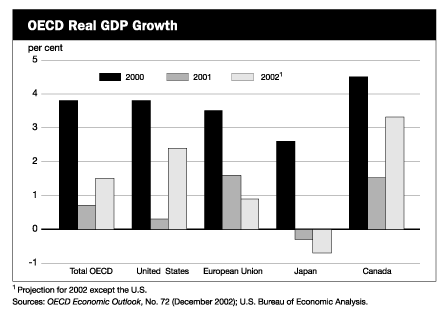
- The external economic environment has been challenging over the past two years.
- World economic conditions deteriorated considerably in 2001, with all major economies experiencing a significant slowdown in growth, including recessions in the U.S., Japan and Germany.
- While the global economy began to recover in late 2001, the recovery through 2002 has been relatively modest and uneven, in the context of ongoing economic, financial and geopolitical uncertainties.
- Growth weakened in Europe in 2002. Japan, which experienced negative growth in 2001, is expected to have remained in recession in 2002. While the U.S. experienced a recovery in 2002, quarterly growth has remained uneven.
The U.S. recovery has been uneven
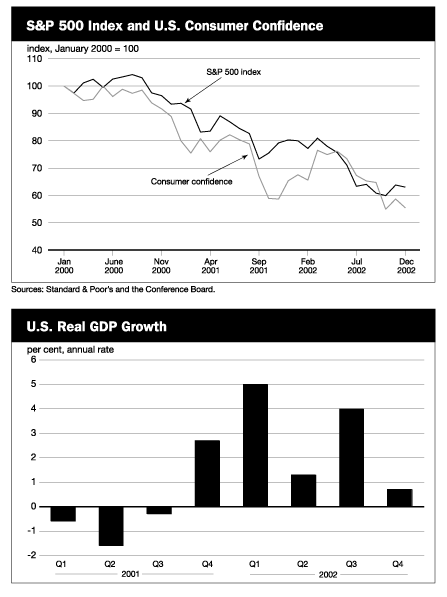
- After stabilizing late in 2001, U.S. equity markets declined sharply again in the summer of 2002 in the wake of accounting and corporate scandals which undermined investor confidence. Combined with a weak labour market and uncertainty about the impact of a possible conflict in Iraq, U.S. consumer confidence declined throughout most of 2002.
- The pace of the U.S. economic recovery to date has been uneven and has not maintained solid momentum. While low interest rates and recent fiscal measures have generally helped to support household demand over the recovery, the pattern of real output growth through 2002 has been strongly influenced by special factors such as the need for firms to replenish depleted inventories early in the year, and later in the year by generous automotive sales incentives that led consumers to bring forward expenditures. Business investment levels remain well below those in 2000.
- The pull-back of the temporary automotive incentives early in the fourth quarter of 2002, along with the impact of significant equity market declines on household wealth and consumer confidence, led to a sharp slowdown in consumer spending. As a result, U.S. real gross domestic product (GDP) growth in the fourth quarter was only 0.7 per cent—down from 4 per cent in the third quarter. For 2002 as a whole, real GDP growth in the U.S. was 2.4 per cent.
Canadian growth outperformed that of the United States during the 2001 global downturn and the 2002 recovery

- Over the past two years Canada’s economy has demonstrated remarkable resilience in the face of global uncertainty.
- The Canadian economy performed better than the U.S. economy in the 2001 global slowdown; real GDP actually rose in Canada while it declined in the U.S.
- This stands in sharp contrast to our poorer performance in the recessions of the early 1980s and early 1990s. During those two recessions real GDP in Canada declined more than in the U.S.
- The Canadian economy also continued to outperform the U.S. economy during the 2002 recovery. Over the first three quarters of 2002 real GDP growth averaged 4.4 per cent (annualized) in Canada compared to 3.4 per cent in the U. S.
- The robust performance of the Canadian economy was reflected in a surging labour market throughout 2002. During the year 560,000 jobs were created in Canada, compared with a decline of 229,000 jobs in the U.S.
Canada’s performance has been led by solid domestic demand
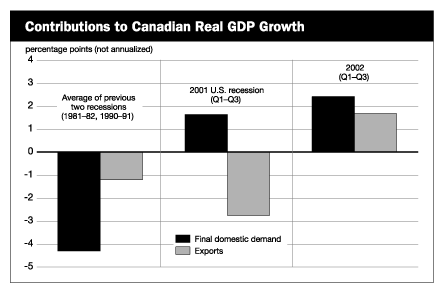
- Domestic demand was a source of strength for Canada in the global downturn of 2001 and recovery of 2002, in sharp contrast to the early 1980s and early 1990s. Strong consumer demand and significant growth in residential investment led the solid recovery from the 2001 slowdown, supported by lower taxes, low interest rates, strong employment growth and rising incomes.
Canada’s employment performance in 2002 was stellar

- During 2002 the Canadian economy created 560,000 new jobs. This represents the largest number of jobs created over any 12-month period on record back to 1976 and the fastest growth rate in 15 years (3.7 per cent). Moreover, there were job gains in most sectors of the economy and over 60 per cent of these new jobs were full-time.
- All age groups benefited from the strong job creation, including youths and adults over the age of 55—two groups that often face more difficulty finding employment.
- The strength in the labour market translated into employment growth for all regions, with Saskatchewan and Quebec leading the way. Employment growth was also robust in British Columbia, Alberta, New Brunswick and Ontario.
- Employment fell slightly in January 2003, as a gain of 34,400 full-time jobs was offset by a decline of 36,500 part-time jobs.
Canada’s unemployment rate gap with the U.S. has narrowed

- Strong employment gains in Canada raised the proportion of the working-age population holding a job—the employment rate—to an all-time high of 62.4 per cent in December 2002 (it stood at 62.3 per cent in January 2003). In contrast, the weakness in the U.S. labour market led to a decline in the employment rate over the course of 2002. The employment rates in Canada and the U.S. are now about the same for the first time since 1982.
- The Canadian unemployment rate edged down from 8 per cent at the end of 2001 to 7.4 per cent in January 2003. As a result, the Canada–U.S. unemployment rate gap fell to 1.7 percentage points in January 2003. If the Canadian unemployment rate were measured using U.S. methodology, the gap would be only 1 percentage point—one of the smallest gaps since the early 1980s.
- The strength of the Canadian labour market in 2002 is further evidenced by the large rise in the participation rate (the share of the working-age population that is working or actively looking for work). This increase is notable, particularly at this stage of the economic cycle. The participation rate reached 67.5 per cent in December, a level equalled only once before in January 1990. The participation rate fell slightly in January 2003 to 67.3 per cent.
Strong fundamentals, led by an improved fiscal position and low inflation, have supported Canada’s solid economic performance
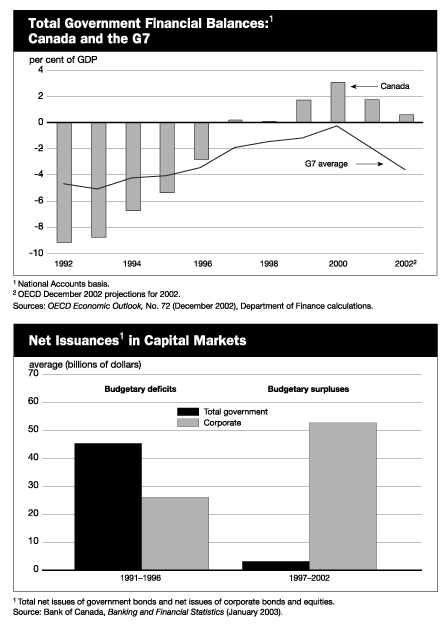
- Canada’s resilient economic performance during the global slowdown was underpinned by the sharp turnaround in the fiscal situation and sustained low inflation. This enabled fiscal and monetary policy to provide support to the Canadian economy through lower taxes and low interest rates.
- Over the last few years the fiscal position of Canadian governments has improved dramatically—moving from large chronic deficits to consistent budgetary surpluses. Canada has recorded the highest financial surplus relative to the size of the economy of all G7 countries annually since 1997.
- 2002 will mark the sixth consecutive year of budget surpluses for Canada. This is the result of a systematic fiscal strategy, based on a prudent approach to budget planning.
- This fiscal strategy enabled the federal government to stay in surplus during the recent global economic downturn while fully implementing the five-year $100-billion tax cut plan and taking new measures in the December 2001 budget to enhance security for Canadians. This is in stark contrast to the U.S. and other G7 countries, which have growing fiscal deficits.
- One of the many benefits of eliminating government deficits can be seen in capital markets. A sharp reduction in government borrowing in Canadian capital markets, together with lower interest rates, has encouraged business investment. Canada’s corporate bond and equity issues have expanded as government debt issuance has declined.
With Canada’s stronger economic and fiscal performance, our current account balance and net foreign indebtedness have improved significantly
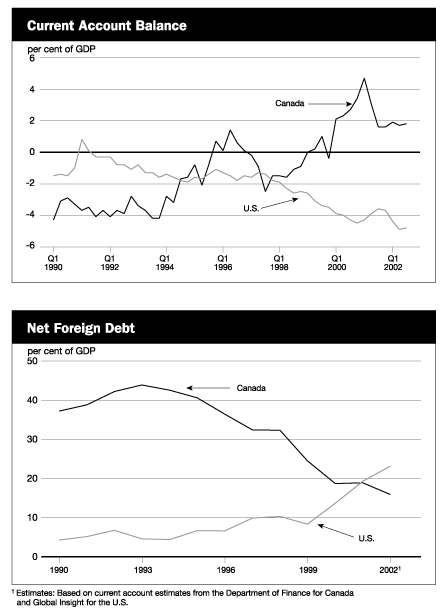
- Canada’s stronger economic performance and improved business competitiveness in recent years can also be seen in our current account balance, which has gone from large deficits through the 1980s and most of the 1990s to large surpluses today despite the U.S. slowdown.
- As a result, Canada’s net foreign debt as a per cent of GDP fell from 44 per cent in the early 1990s to an estimated 16 per cent in 2002—the lowest level in more than 50 years. This benefits us by reducing our net investment income flows to foreigners and lowering our exposure to global financial market shocks.
- Canada’s net foreign debt is now below that of the U.S. With continuing budgetary and current account surpluses expected in Canada, and continuing deficits anticipated in the U.S., Canada’s net foreign indebtedness should continue to fall and the gap vis-à-vis the U.S. continue to widen.
Sustained balanced budgets and a proven record of low and stable inflation have increased the Bank of Canada’s room to manoeuvre
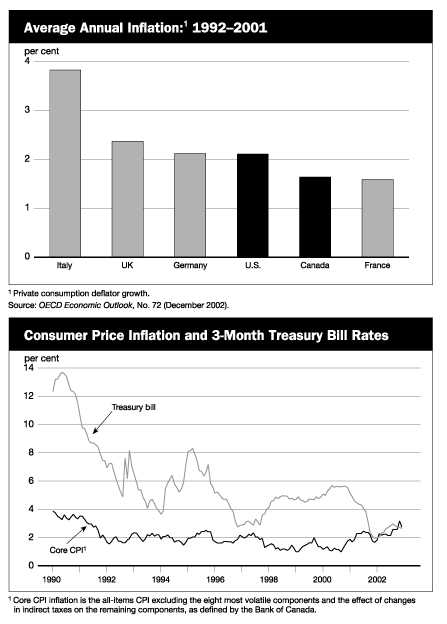
- Low and stable inflation in Canada over the past decade—among the lowest in the world—has established the credibility of Canadian inflation targets.
- Combined with the turnaround in Canada’s fiscal position, this credibility has given monetary authorities room to manoeuvre through the economic downturn and uneven global recovery. The Bank of Canada was able to lower interest rates in 2001 as soon as the economy showed signs of weakness. Short-term interest rates remain close to their lowest level in more than 40 years and continue to support growth in Canadian domestic demand.
- Total consumer price inflation rose above the 1 to 3 per cent target band to 3.8 per cent in the fourth quarter of 2002, partly reflecting one-off factors such as higher electricity prices in Ontario and substantial increases in insurance premiums, as well as rising prices for gasoline, fuel oil and natural gas. Core consumer price inflation, which excludes the volatile components of the Consumer Price Index and the effect of indirect taxes, was 2.8 per cent in the fourth quarter of 2002, above the 2-per-cent mid-point but within the target band. The Bank of Canada expects core inflation to move down to 2 per cent in early 2004.
Unlike the U.S., Canadian consumer confidence has been resilient
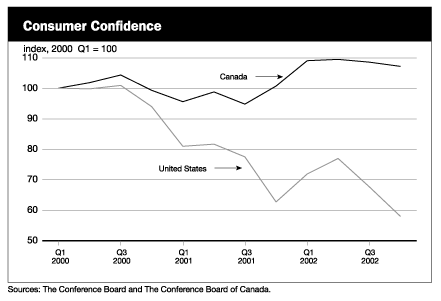
- Canadian consumer confidence remained high in 2002, at almost 15 per cent above its historical average and 12 per cent above its trough in the third quarter of 2001.
- The resilience of Canadian consumer confidence reflects strong employment growth, sustained strong disposable income growth boosted by large tax cuts, and historically low interest rates.
- In contrast, U.S. consumer confidence has fallen by over 40 per cent since the third quarter of 2000, reflecting weak labour market conditions, declines in equity market prices and geopolitical risks.
Housing activity has been exceptionally strong

- Residential investment has been particularly strong in the recovery, with the robust performance of both housing starts and renovations.
- Strong employment and income gains, along with low mortgage rates, boosted housing starts to a record level of over 200,000 in 2002. Robust housing activity has been spread across all regions of the country.
- The housing affordability index, which represents the proportion of average disposable household income needed to make mortgage payments on an average house, improved throughout 2001 and remained close to its historical best in 2002.
- In February 2003 one-year and five-year mortgage rates, at 4.9 per cent and 6.6 per cent, were 280 and 135 basis points lower than their levels at the beginning of 2001. As a result, homeowners now save close to $2,000 annually on a typical one-year mortgage of $100,000 compared to what they would have paid at the beginning of 2001, while they save $1,000 annually on a five-year mortgage.
- Similarly, declines in interest rates for businesses mean that annual payments on small business loans of $250,000 tied to the prime rate would be $7,500 lower than they were at the beginning of 2001.
Corporate profits and business confidence remain high...
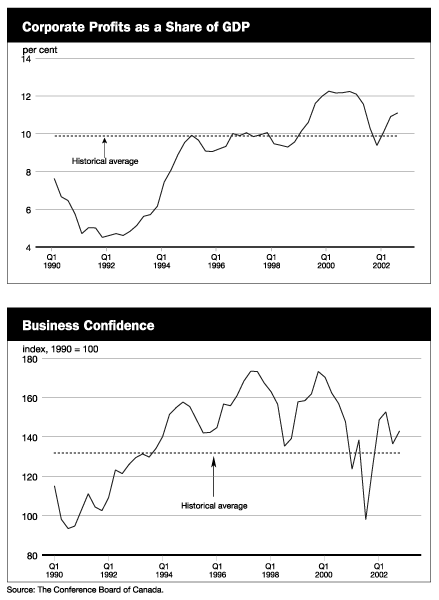
- Following a sharp decline to 9.4 per cent of nominal GDP in the fourth quarter of 2001, corporate profits in Canada rebounded to 11.1 per cent of GDP by the third quarter of 2002, well above the historical average of 9.9 per cent.
- Supported by this recovery in corporate profits, business confidence in Canada bounced back in the first half of 2002 after declining in 2001. Although business confidence fell somewhat in the second half of 2002, reflecting geopolitical risks and uncertainty about the pace of the U.S. economic recovery, the index has remained above its historical average.
- The December 2002 Quarterly Business Barometer of the Canadian Federation of Independent Business indicated that confidence of small and medium-sized businesses—which is much more dependent on domestic demand conditions—remains close to historical highs.
…which bodes well for future investment

- Business investment in machinery and equipment (M&E) has recently shown signs of improvement, supported by rising profits and indications that the Canadian economy’s pace of growth will be sustained.
- While the level of M&E investment in the third quarter of 2002 was still below the level recorded a year earlier, the ongoing recovery in corporate profits and business confidence should support further gains in business investment.
- Canadian real M&E investment has improved significantly in recent years, growing by an average of over 8 per cent a year since 1997. M&E investment, which frequently embodies new technologies and enables further innovation, is an important element of sustaining productivity gains in the long run.
Improved fundamentals and increased business investment have strengthened our productivity performance...
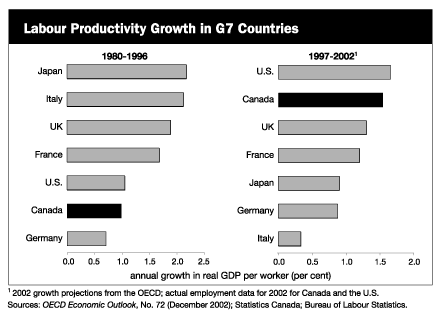
- Canada’s productivity performance has improved significantly since 1997. Measured as real GDP per worker, labour productivity growth in Canada rose from an average of 1 per cent per year over the 1980–96 period to an estimated 1.5 per cent over the 1997–2002 period.
- Growth in real GDP per hour worked in the Canadian business sector was even stronger, with productivity growth averaging 2.1 per cent from 1997 to 2002, up from 1.2 per cent over the 1980–96 period.[1]
- Despite this improvement, productivity growth in the U.S. was still higher than in Canada over the past two decades. Nevertheless, over the 1997–2002 period Canada ranked second in the G7 in productivity growth—an improvement from second to last over the 1980–96 period.
- The shift to budgetary surpluses from sustained deficits, a lower debt-to-GDP ratio, lower tax burdens and low inflation have stimulated investment and contributed to Canada’s improved productivity growth.
...and this improved productivity growth, plus Canada’s superior labour market performance, has generated stronger growth in living standards

- Living standards can be raised both by increasing the share of the population that is working and by increasing the productivity of workers.
- Canada has improved its performance on both fronts since 1997 and, as a result, has recorded the strongest growth in real GDP per capita—the most common measure of living standards—of all G7 countries. In contrast, over the 1980–96 period Canada ranked second to last among the G7 countries in living standards growth.
- Canadian employment growth relative to the population surpassed that of all other G7 economies over the 1997–2002 period. While the U.S. has continued to achieve faster labour productivity growth than Canada since 1997, these gains have been offset by a weaker labour market performance, resulting in slower living standards growth than in Canada.
- Further improvement in Canada’s productivity performance will be necessary to sustain growth in living standards in the long run. Economic factors such as fiscal and monetary stability, competitive taxes, investment in learning, new technologies and research and innovation are all key to helping Canada improve its productivity performance. Equally important is investing in our social capital to provide Canadians with the skills, confidence and opportunities to participate in the changing economy.
Forecasters expect continued solid growth in the Canadian economy
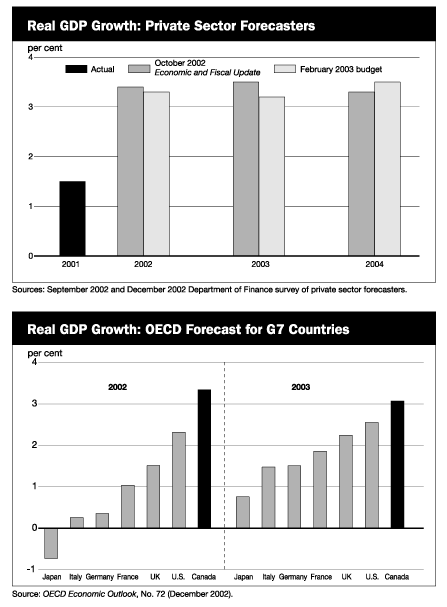
- The fiscal projections in the budget are based on private sector economists’ forecasts for the Canadian and global economies.
- In September 2002 the Department of Finance conducted its regular survey of Canadian private sector economists. The average economic forecast from that survey was the basis for the status quo fiscal projections provided in the October 2002 Economic and Fiscal Update.
- In December 2002 the Department of Finance updated this survey of Canadian private sector economists in preparation for the 2003 budget. The fiscal projections provided in Chapter 8 of this budget are based on this updated outlook.
- Private sector forecasters now expect Canadian economic growth of 3.3 per cent in 2002, with roughly 21/2 per cent growth in the fourth quarter. Forecasters have modestly revised downward their projection for real GDP growth in 2003 to 3.2 per cent from the 3.5 per cent expected at the time of the October 2002 Economic and Fiscal Update, reflecting a weaker short-term U.S. outlook. For 2004 private sector forecasters have revised up slightly their growth outlook for Canada to 3.5 per cent, reflecting an expected rebound in U.S. growth.
- GDP inflation is expected to remain low at 1.1 per cent in 2002, but to increase to about 2 per cent in 2003 and 2004. Stronger GDP inflation in 2003 largely reflects rising oil prices. Overall, this results in expected nominal GDP growth of 4.4 per cent in 2002 and 5.4 per cent in both 2003 and 2004.
- Private sector forecasters expect short-term interest rates to be 60 basis points lower in 2003 and 20 basis points lower in 2004 than projected at the time of the October 2002 Economic and Fiscal Update. They expect short-term interest rates of 3.3 per cent in 2003 and 4.5 per cent in 2004. Current private sector expectations for 10-year government bonds are at 5.4 per cent in 2003 and 5.9 per cent in 2004.
- Private sector forecasters expect continuing robust employment growth, with the unemployment rate falling to 7 per cent by the end of 2003.
- The IMF and OECD continue to expect that Canadian growth will be the strongest in the G7 in 2003.
Table 2.1
Private Sector Forecasts for 2002 to 2004
|
|
|||
| 2002 | 2003 | 2004 | |
|---|---|---|---|
|
|
|||
| Real GDP growth | |||
| December 2001 budget | 1.1 | 3.9 | 3.6 |
| October 2002 update | 3.4 | 3.5 | 3.3 |
| February 2003 budget | 3.3 | 3.2 | 3.5 |
| GDP inflation | |||
| December 2001 budget | 0.2 | 1.9 | 2.0 |
| October 2002 update | 1.1 | 2.3 | 2.1 |
| February 2003 budget | 1.1 | 2.2 | 1.9 |
| Nominal GDP growth | |||
| December 2001 budget | 1.3 | 5.9 | 5.7 |
| October 2002 update | 4.6 | 5.9 | 5.4 |
| February 2003 budget | 4.4 | 5.4 | 5.4 |
| 3-month Treasury bill rate | |||
| December 2001 budget | 2.4 | 4.0 | 5.3 |
| October 2002 update | 2.6 | 3.9 | 4.7 |
| February 2003 budget | 2.6 | 3.3 | 4.5 |
| 10-year government bond rate | |||
| December 2001 budget | 5.5 | 5.9 | 6.1 |
| October 2002 update | 5.3 | 5.5 | 5.6 |
| February 2003 budget | 5.3 | 5.4 | 5.9 |
| Unemployment rate | |||
| December 2001 budget | 7.6 | 7.1 | 6.6 |
| October 2002 update | 7.6 | 7.1 | 6.9 |
| February 2003 budget | 7.6 | 7.3 | 7.0 |
| Employment growth | |||
| December 2001 budget | 0.6 | 1.9 | 1.8 |
| October 2002 update | 1.9 | 2.1 | 1.8 |
| February 2003 budget | 2.1 | 2.1 | 1.8 |
| Addendum: | |||
| U.S. real GDP growth | |||
| December 2001 budget | 1.1 | n/a | n/a |
| October 2002 update | 2.4 | 3.0 | n/a |
| February 2003 budget | 2.4 | 2.7 | 3.6 |
|
|
|||
| Sources: September 2001, September 2002 and December 2002 Department of Finance surveys of private sector forecasters; November 2001, October 2002 and February 2003 Blue Chip Economic Indicators. | |||
Downside risks to the U.S. and global outlooks remain
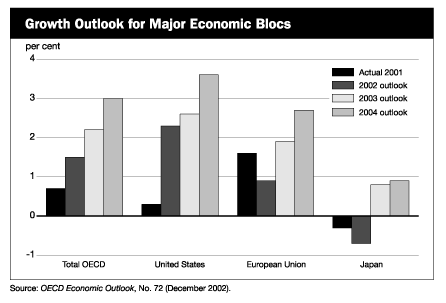
- Canada will continue to face a challenging global and U.S. economic environment over the coming year. The global recovery, particularly outside North America, is proceeding at a relatively slow pace.
- Japan is expected to emerge from recession in 2003, although the outlook for the next two years remains weak. Growth is expected to be stronger in Europe in 2003 than in 2002, although it is forecast to remain below 2 per cent.
- The U.S. recovery is expected to continue and gain momentum in the second half of 2003 as the recovery in business investment takes hold. However, the U.S. outlook continues to be subject to considerable uncertainty arising from the impact of last year’s equity market declines and the geopolitical risks associated with a possible conflict in Iraq.
- These factors likely played a role in the slowing of U.S. growth late in 2002 and could continue to negatively affect business investment and consumer sentiment in the near term. Moreover, if the disruption of Venezuelan oil production continues, this May place additional upward pressure on oil prices, further reducing global growth prospects.
Note: This chapter incorporates data available up to February 7, 2003.
1 The estimate for the 1997–2002 period assumes that 2002 Q4 growth equals the average growth over the first three quarters of the year.[Return]
- Table of Contents - Previous - Next -
| Last Updated: 2003-02-18 |
| ||||